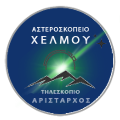Two major European collaborative networks for ground-based astronomy, in the optical/infrared domain (OPTICON) and in the radio-wave domain (RadioNet) are now merged into one project/network (OPTICON-RadioNet Pilot or ORP), which brings together around twenty telescopes and telescope arrays.
Since 2003 National Observatory of Athens (and Aristarchos telescope) becomes an OPTICON partner, while since January 1, 2016, the 2.3m Aristarchos telescope participates in the TNA program, making its instrumentation available to the international community. Now, the Aristarchos telescope continues as a full member of the Opticon-Radionet Pilot project.
OPTICON
OPTICON (Optical Infrared Coordination Network for Astronomy) (https://www.astro-opticon.org/) was an EC-funded coordination network which supported the multi-national partnerships. The idea behind OPTICON was to bring together scientists from all the national and international agencies and organizations which funded, supported, developed and operated European facilities for optical and infrared astronomy. OPTICON also incorporated the following activities: networking activities (NA), trans-national access (TNA) and joint research activities (JRA). The Trans National Access (TNA) program offered open-access to a network of small and medium size telescopes for cutting edge research. JRA activities supported the development of new technologies in photonics, in new materials, in manufacturing processes, in instrumentation.

RadioNet
RadioNet (https://www.radionet-org.eu/radionet/) was also an EC-funded program which was coordinated and supported access to top-level research & development (R&D) programs for radio facilities. RadioNet also assured that European radio astronomy maintains its leading role with the next-generation facilities such as the the Atacama Large Millimetre Array (ALMA) and the ESFRIlisted Square Kilometre Array (SKA) by involving scientists and engineers in the scientific use and innovation of the outstanding European facilities The main actions of the RadioNet program included: (I) to European telescope facilities: financial support for transnational access to world class telescope facilities and support for innovative JRA, (II) to astronomers, engineers, students: comprehensive networking and training opportunities and (III) to policy and decision makers: coordination of European radio astronomy policy, development, and training.
OPTICON RadioNet Pilot (ORP)
In March 2021, the optical and radio communities decided to come together in the Opticon RadioNet Pilot (ORP) (https://www.orp-h2020.eu/) providing for the first time a coordinated and coherent plan for access to a set of optical/infrared and radio facilities, support and training for multi-wavelength astronomers, and specific developments to improve the capabilities of facilities.
ORP represents the largest and most comprehensive network of facilities/observatories across Europe (and around the world) covering the optical, infra-red, sub-mm and radio wavebands. The aim of ORP is to bring together experts from the astronomy community, to develop access to optical, infrared and radio facilities in an efficient and co-ordinated way.
The Opticon RadioNet Pilot project is funded by the European Union’s Horizon 2020 (H2020) research and innovation program. The French National Centre for Scientific Research (CNRS) coordinates the project, together with the University of Cambridge and the Max-Planck Institute for Radio Astronomy. Astronomers from 15 European countries (Greece is included with the 2.3m Aristarchos Telescope at Helmos Observatory), Australia and South Africa, as well as from 37 institutions (NOA), have already joined the ORP consortium.

OPTICON Observations
The following observations have been performed under OPTICON awarded time. According to OPTICON/H2020 rules the data become public one year after the observations have been obtained.
List of awarded projects:
